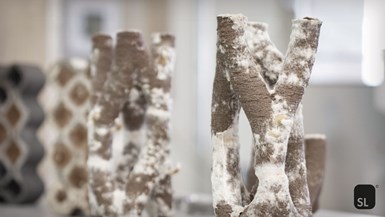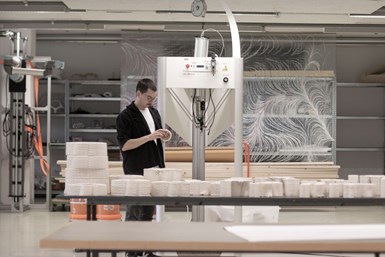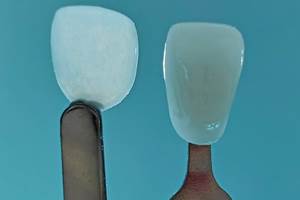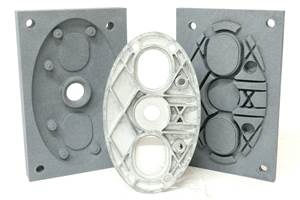Shape Lab Develops MyCera to Reinforce 3D Printed Clay Structures
Mycelium is an intelligently oriented fiber reinforcement that can increase the structural performance of 3D printed unfired clay elements and enable bio-welding of fired elements.
3D printing with mycelium-reinforced clay structures. Photo Credits: Shape Lab - Institute of Architecture and Media, Graz University of Technology
The Shape Lab research group — located at the Institute of Architecture and Media at Graz University of Technology — has developed a new material, MyCera, for 3D printing mycelium-reinforced structures. The material is composed of clay, wood sawdust and mycelium (vegetative part of fungi). The material is the result of research which focused on using mycelium as an intelligently oriented fiber reinforcement to increase the structural performance of 3D printed unfired clay structures and enable bio-welding of fired elements.
After initial testing, researchers say the proposed material composition could replace cement-based binders and offer a new approach to the sustainable fabrication of buildings in the near future.
The Shape Lab team used a Delta WASP 40100 Clay 3D printer to carry out their research and successfully print MyCera, taking advantage of the machine’s open system, scale and compatibility with paste-based material. Researchers say the overall research goal focused on finding a viable, long-term solution to the global problem of waste management and CO2 emissions, which also affects the building industry and construction waste management.
According to the researchers, mycelium has been proven to both increase the structural performance of clay 3D printed elements and act as a bio-binder between different pieces, creating a stable combined structure. MyCera showed notable structural properties when compared to the same material mixture without mycelium. It is assumed that the high increase in tensile strength is caused by the growth process that takes place after printing. This kind of intelligent fiber distribution could not have been achieved with a non-growing material.
The mycelium not only enhances the structural performance of 3D printed clay but also serves as a means to bio-weld various components together. Various structures were produced by assembling multiple elements together in a state where mycelium continues its growth. Mycelium fibers of the still-growing node elements formed connections through the expansion of the hyphal network and bio-welded adjacent elements together.
Although more tests need to be done to assert its durability, Shape Lab says that MyCera is a promising new composite material that could define a new approach to the sustainable fabrication of buildings in the near future. To verify the assumption of an advantageous structural effect of grown fiber connections, a comparison of mycelial fiber reinforcement and other fibers that are commonly used to increase tensile strength (such as basalt and glass fibers) is planned.
For more details on the research project, read the full WASP article. Watch process highlights in this video.
- Learn more about Wasp’s polymer and ceramic 3D printers for customized serial production. Italy-based Wasp offers 3D printing options for sustainable, customized serial production with polymers and ceramics.
- Read more about ceramics in this article on “10 Important Developments in Additive Manufacturing Seen at Formnext 2022.” And watch a short video from the trade show in which AM Editor-in-Chief Pete Zelinski shows a WASP 3D printing system for ceramics.
Related Content
BMF Receives FDA Clearance for UltraThineer Dental Veneer Material
The zirconia materials are now qualified for use in the production of the world’s thinnest cosmetic veneers, which require significantly less tooth preparation or grinding, thereby preserving more of the patient’s natural enamel.
Read MoreFormlabs Expands SLA/SLS Ecosystem With New Materials, Postprocessing Tools
The new hardware, software and materials are designed to streamline postprocessing and unlock new workflows.
Read MoreFoundry Lab: How Casting in a Day Will Improve the Design of Metal Parts (Includes Video)
The company’s digital casting process uses 3D printing, but the result is a cast part. By providing a casting faster than a foundry, the company says effective prototyping is now possible for cast parts, as well as bridge production.
Read MoreLithoz CeraFab System S320 LCM Printer Designed for Efficient, High-Capacity Industrial Serial Production
Formnext 2024: The system offers a build speed of up to 150 layers per hour and layer thickness of 20–200 µm.
Read MoreRead Next
Crushable Lattices: The Lightweight Structures That Will Protect an Interplanetary Payload
NASA uses laser powder bed fusion plus chemical etching to create the lattice forms engineered to keep Mars rocks safe during a crash landing on Earth.
Read MorePostprocessing Steps and Costs for Metal 3D Printing
When your metal part is done 3D printing, you just pull it out of the machine and start using it, right? Not exactly.
Read MoreProfilometry-Based Indentation Plastometry (PIP) as an Alternative to Standard Tensile Testing
UK-based Plastometrex offers a benchtop testing device utilizing PIP to quickly and easily analyze the yield strength, tensile strength and uniform elongation of samples and even printed parts. The solution is particularly useful for additive manufacturing.
Read More






















